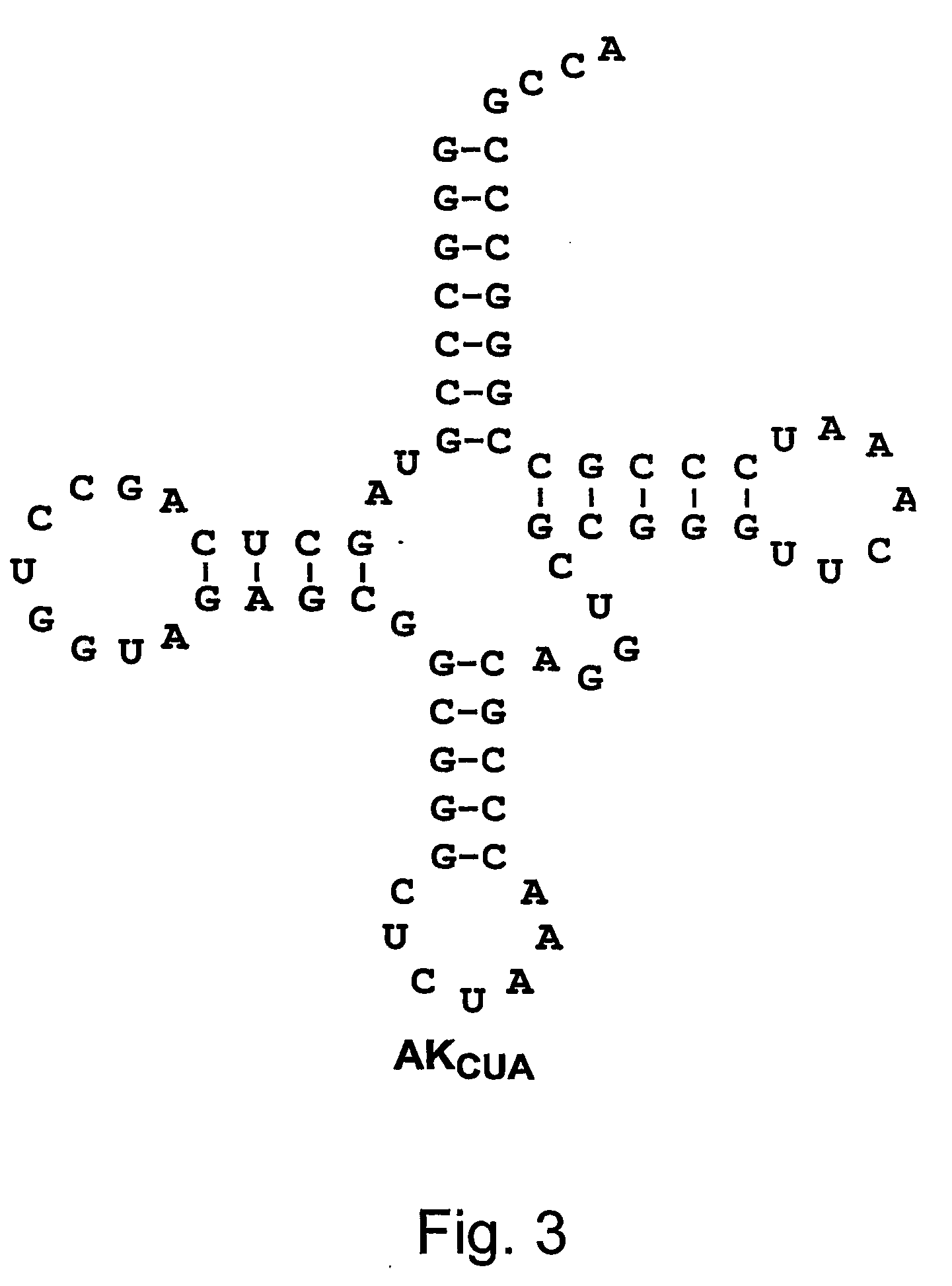Compositions of orthogonal lysyl-trna and aminoacyl-trna synthetase pairs and uses thereof
a technology of aminoacyltrna and lysyltrna, which is applied in the field of translation biochemistry, can solve the problem of restricting the ultimate number of amino acids encoded by, and achieve the effect of suppressing efficiency
- Summary
- Abstract
- Description
- Claims
- Application Information
AI Technical Summary
Benefits of technology
Problems solved by technology
Method used
Image
Examples
example 1
Production of Orthogonal Synthetase / tRNA Pair Derived from Archael tRNALYS
[0203] An orthogonal synthetase-tRNA pair was constructed from the lysyl-tRNA synthetase of Pyrococcus horikoshii. Using an amber suppressor tRNA derived from the consensus of a multiple sequence alignment of archeal tRNAlys sequences, 32% amber suppression was observed in β-galactosidase assays. As such, this pair is a highly efficient system for the selective incorporation of unnatural amino acids into protein in E. coli.
[0204] The expansion of the genetic code of an organism to include additional amino acids beyond the common twenty requires a minimum of two novel genes: an aminoacyl-tRNA synthetase that selectively activates the unnatural amino acid and does not transfer the amino acid to endogenous tRNAs; and a cognate orthogonal tRNA that accepts the unnatural amino acid and is not charged by endogenous synthetases (Furter, (1998) Protein Sci., 7:419-426). In addition, the tRNA deliver the amino acid i...
example 2
Frameshift Suppression with an Unnatural Amino Acid Eliminating the Toxicity of PHKRS
[0212] An orthogonal tRNA-synthetase pair derived from the type I lysyl-tRNA synthetase of Pyrococcus horikoshii has been developed for use in E. coli. The tRNA portion of the system functioned very well as an orthogonal amber suppressor. The synthetase-expression plasmid pKQ-PhE444G was able to charge this tRNA, but toxicity effects were still observed. When expressed alone, cells harboring pKQ-PhE444G grow to 56% of the density observed for cells with no plasmid. Reporter plasmids pAC-AKCUA and pAC-AKCUA show moderate toxicity as well, growing to 71% and 52%. When pKQ-PhE444G is cotransformed with plasmid pAC-AKCUA, cell density is decreased to 17%. In addition, cells reach a density of only 5% when coexpressed with the β-lactamase reporter plasmid pAC-AKCUA (a derivative of plasmid pACKO-A184TAG). It is therefore clear that there is toxicity with both the tRNA and the synthetase in this system. ...
example 3
Expanding the Genetic Code with Four-Base Codons and Unnatural Amino Acids
[0215] Although, with few exceptions, the genetic codes of all known organisms encode the same twenty amino acids, all that is required to add a new building block are a unique tRNA / aminoacyl-tRNA synthetase pair, a source of the amino acid, and a unique codon that specifies the amino acid (Wang et al., (2001) Expanding the genetic code. Science 292:498-500). Previously, we have shown that the amber nonsense codon, TAG, together with orthogonal M. jannaschii and E. coli tRNA / synthetase pairs can be used to genetically encode a variety a variety of amino acids with novel properties in E. coli (Wang et al., (2003) Addition of the keto functional group to the genetic code of Escherichia coli. Proc. Natl. Acad. Sci. U.S.A. 100:56-61; Santoro et al., (2002) An efficient system for the evolution of aminoacyl-tRNA synthetase specificity. Nat. Biotechnol. 20:1044-8; Chin et al., (2002) Addition of a photocrosslinking...
PUM
| Property | Measurement | Unit |
|---|---|---|
| Tm | aaaaa | aaaaa |
| volume | aaaaa | aaaaa |
| concentrations | aaaaa | aaaaa |
Abstract
Description
Claims
Application Information
 Login to View More
Login to View More - R&D
- Intellectual Property
- Life Sciences
- Materials
- Tech Scout
- Unparalleled Data Quality
- Higher Quality Content
- 60% Fewer Hallucinations
Browse by: Latest US Patents, China's latest patents, Technical Efficacy Thesaurus, Application Domain, Technology Topic, Popular Technical Reports.
© 2025 PatSnap. All rights reserved.Legal|Privacy policy|Modern Slavery Act Transparency Statement|Sitemap|About US| Contact US: help@patsnap.com



